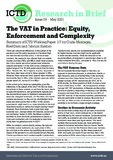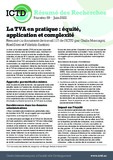The VAT in Practice: Equity, Enforcement and Complexity
La TVA en pratique : équité, application et complexité
| dc.contributor.author | Mascagni, Giulia | |
| dc.contributor.author | Dom, Roel | |
| dc.contributor.author | Santoro, Fabrizio | |
| dc.date.accessioned | 2021-05-14T11:23:25Z | |
| dc.date.available | 2021-05-14T11:23:25Z | |
| dc.date.issued | 2021-05 | |
| dc.identifier.citation | Mascagni, G., Dom, R. and Santoro, F. (2021) The VAT in Practice: Equity, Enforcement and Complexity. ICTD Research in Brief 69, Brighton: Institute of Development Studies | en |
| dc.identifier.uri | https://opendocs.ids.ac.uk/opendocs/handle/20.500.12413/16603 | |
| dc.description.abstract | The value added tax (VAT) is supposed to be a tax on consumption that achieves greater economic efficiency than alternative indirect taxes. It is also meant to facilitate enforcement through the ‘self-enforcing mechanism’ – based on opposed incentives for buyers and sellers, and because of the paper trail it creates. Being a rather sophisticated tax, however, the VAT is complex to administer and costly to comply with, especially in lower-income countries. This paper takes a closer look at how the VAT system functions in practice in Rwanda. Using a mixed-methods approach, which combines qualitative information from focus group discussions with the analysis of administrative and survey data, we document and explain a number of surprising inconsistencies in the filing behaviour of VAT-remitting firms, which lead to suboptimal usage of electronic billing machines, as well as failure to claim legitimate VAT credits. The consequence of these inconsistencies is twofold. It makes it difficult for the Rwanda Revenue Authority to exploit its VAT data to the fullest, and leads to firms, particularly smaller ones, bearing a higher VAT burden than larger ones. There are several explanations for these inconsistencies. They appear to lie in a combination of taxpayer confusion, fear of audit, and constraints in administrative capacity. Summary of ICTD Working Paper 117 by Giulia Mascagni, Roel Dom and Fabrizio Santoro | en |
| dc.description.abstract | La taxe sur la valeur ajoutée (TVA) est la plus importante source de revenus dans de nombreux pays, mobilisant en moyenne environ un quart du total des recettes fiscales collectées, et près de 40 % dans les pays africains (Ebril et al. 2001 ; Keen 2012 ; ATAF 2019). L’argument théorique en faveur de l’adoption d’une TVA, par opposition à d’autres taxes sur la consommation, est largement soutenu par les experts fiscaux et les universitaires. Cependant, même les plus fervents soutiens de la TVA reconnaissent que dans la pratique, son application est souvent problématique, surtout dans les pays à faible revenu. La présente recherche examine le fonctionnement du système de TVA dans la pratique au Rwanda, avec un accent sur les implications importantes pour l’équité et l’efficacité. | fr |
| dc.description.sponsorship | UKAID | en |
| dc.description.sponsorship | Bill and Melinda Gates Foundation | en |
| dc.language.iso | en | en |
| dc.publisher | Institute of Development Studies | |
| dc.rights.uri | http://creativecommons.org/licenses/by-nc/4.0/ | en |
| dc.subject | Trade | en |
| dc.title | The VAT in Practice: Equity, Enforcement and Complexity | en |
| dc.title | La TVA en pratique : équité, application et complexité | fr |
| dc.type | Series paper (non-IDS) | en |
| dc.rights.holder | Institute of Development Studies | en |
| rioxxterms.version | NA | en |



